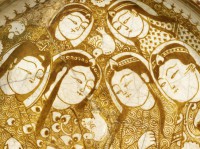Islamic Ceramics trail
Explore over one thousand years of development in Islamic ceramics through our extensive collection.

- This is a visual browsing tool that maps objects in this publication, gallery or collection trail by date of creation onto a timeline.
- The circular markers indicate where objects are on the timeline.
- The size of the markers indicates the relative number of objects at that point on the timeline.
- Hover over a marker to find out which objects are represented at that point in time.
- To expand, collapse or hide the timeline, click these symbols
 found at the top right of the timeline.
found at the top right of the timeline.
- 780
- 820
- 860
- 900
- 940
- 980
- 1020
- 1060
- 1100
- 1140
- 1180
- 1220
- 1260
- 1300
- 1340
- 1380
- 1420
- 1460
- 1500
- 1540
- 1580
- 1620
From an early stage, Islamic potters were able to create an incredibly wide range of decorated ceramics with simple materials and techniques.
There was great variety in the ceramics produced in Iran and Central Asia from about the 10th century using fine, diluted clays, or slips, to coat and paint earthenware. The manufacture and use of these ceramics seem to have been localised in this area, as opposed to the wide distribution found with lustre and cobalt painted ware from Iraq.
Decorative techniques
A coat of white slip was an easy way for potters to provide vessels made of red clay with a white background on which they could apply different types of decoration. Incised decoration through this slip was favoured in Iran from the 10th century well into the 13th century. The earliest examples seem to be those combining incised patterns with splashes of colour, usually green, yellow, and brown. Over the following centuries, Iranian potters continued to experiment on incised and carved wares, trying to increase their control over the colours.
Slip painting
During the 10th and 11th centuries, potters in the eastern Islamic world also developed a number of distinctive slip-painted wares. Their decoration ranged from calligraphy to figures to abstract patterns. The finest surviving pieces are open-form vessels, such as dishes and bowls, coated in a white slip, with lines of writing in black and red slips, under a thin layer of transparent glaze. Aphorisms and good wishes in Arabic are the most common types of text used to decorate these vessels. A reverse colour scheme of painting in white on a black (or coloured) slip ground was occasionally used in pieces with calligraphic decoration, as well as the more abstract wares.
A separate group of eastern Iranian ceramics with geometric and calligraphic-style decoration appears to have been painted with a black slip that released a yellow halo during the firing. This resulted in the staining of the transparent glaze around the painted areas.
A lively repertoire of figural, vegetal, and geometric patterns was used on a unique type of buff-coloured ware, boldly painted with a combination of slips and colours.
© 2013 University of Oxford - Ashmolean Museum





